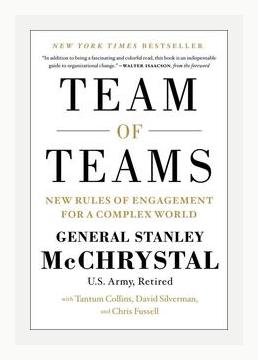Human Resources and Talent ManagementLeadership and ManagementWorkplace CultureTeam BuildingOrganizational Behavior
Summary of “Team of Teams: New Rules of Engagement for a Complex World”
Introduction
“Team of Teams: New Rules of Engagement for a Complex World” by General Stanley McChrystal, along with co-authors Tantum Collins, David Silverman, and Chris Fussell, redefines the principles of organizational behavior, team building, and workplace culture through the lens of McChrystal’s military experience. The premise of the book is centered on how the Joint Special Operations Task Force had to adapt to face the unpredictable challenges posed by Al Qaeda in Iraq (AQI). Leaders in any field can apply these principles to foster resilient and effective teams in complex environments.
1. Complexity and Adaptation
Key Point: Traditional hierarchical models of management are inadequate for facing modern, complex environments.
Example: McChrystal transitioned from a rigid command structure to a flexible, decentralized model to effectively combat AQI. This transition was crucial in enabling faster decision-making and situational awareness.
Actionable Advice:
– Flatten the Hierarchy: Reduce layers in your organization to accelerate information flow and decision-making.
– Empower Frontline Employees: Give more autonomy to employees, especially those directly interacting with customers or executing tasks.
2. Shared Consciousness
Key Point: Creating a shared consciousness across teams enhances situational awareness and fosters unity.
Example: The Task Force utilized daily Operations and Intelligence (O&I) briefings to ensure every team member had access to the same information, creating a comprehensive understanding of evolving situations.
Actionable Advice:
– Daily Briefings: Implement consistent team-wide meetings to disseminate information broadly and promptly.
– Use Technology Smartly: Leverage platforms that enable real-time communication and information sharing.
3. Trust and Purpose
Key Point: Trust among team members and a compelling shared purpose are foundational to effective collaboration.
Example: By building trust and highlighting the shared mission to defeat AQI, McChrystal united diverse teams from various branches of the military and intelligence.
Actionable Advice:
– Build Trust: Engage in team-building activities and create an environment where individuals feel comfortable sharing ideas and vulnerabilities.
– Articulate Purpose: Clearly define and communicate the team’s mission and objectives to ensure alignment.
4. Task Force’s Transformation
Key Point: The Task Force’s transition showcases the practical application of adaptability and inter-team collaboration.
Example: Initially, the Task Force’s efforts against AQI were fragmented. By fostering inter-agency collaboration and mutual support, they effectively dismantled AQI’s network.
Actionable Advice:
– Promote Cross-functional Teams: Encourage collaboration between different departments to leverage diverse skills and perspectives.
– Break Down Silos: Regularly rotate team members or engage them in cross-departmental projects to facilitate knowledge sharing.
5. Leading Like a Gardener
Key Point: Leaders need to shift from a ‘chess master’ mindset to that of a ‘gardener,’ tending to the team’s environment rather than directing every move.
Example: McChrystal spent considerable time fostering relationships and building networks within his team, which, in turn, facilitated organic growth and problem-solving.
Actionable Advice:
– Nurture Relationships: Invest time in getting to know your team members personally and professionally.
– Foster Autonomy: Allow teams to operate independently within a framework of clear guidelines and shared objectives.
6. Balancing Efficiency and Resilience
Key Point: There is a necessary trade-off between efficiency and resilience. Over-optimization can result in fragility.
Example: Special Operations units were streamlined for operational efficiency but became vulnerable to unexpected challenges. Adapting to be more resilient allowed them to sustain operations under pressure.
Actionable Advice:
– Build Redundancies: Create systems and processes that can withstand disruptions by including backups and fail-safes.
– Encourage Experimentation: Allow teams to experiment and learn from failures to build adaptive capabilities.
7. Embracing Diversity
Key Point: Diverse teams are more innovative and better equipped to handle complex problems.
Example: The Task Force included members from various military branches and intelligence agencies, each bringing unique insights and methods to the table.
Actionable Advice:
– Recruit for Diversity: Strive for a team composition that encompasses a variety of backgrounds, experiences, and perspectives.
– Inclusive Practices: Foster an inclusive workplace where every voice is heard and valued.
8. Scaling Trust through Structuring Communication
Key Point: Structure communications effectively to scale trust across larger teams.
Example: The Task Force used a structured format for information sharing that facilitated transparency and trust among members.
Actionable Advice:
– Standardize Communication: Develop standardized communication protocols to ensure clarity and consistency.
– Feedback Loops: Implement mechanisms for regular feedback to ensure open lines of communication.
9. Continual Learning and Adaptation
Key Point: Organizations need to be in a perpetual state of learning and adaptation to thrive.
Example: The Task Force continually adapted their strategies based on real-time feedback and evolving battlefield conditions.
Actionable Advice:
– Foster a Learning Culture: Encourage continuous learning and improvement within teams.
– Be Agile: Adopt agile methodologies that allow for rapid adjustments in response to new information.
10. Transparency and Decentralized Control
Key Point: Transparency enables decentralized control, which in turn fosters a more responsive and dynamic organization.
Example: The dissemination of real-time battlefield intelligence allowed lower-level teams to make informed decisions independently.
Actionable Advice:
– Access to Information: Ensure that relevant information is accessible to all team members to enhance their decision-making capabilities.
– Decentralize Decision Making: Encourage decentralized decision-making to increase responsiveness and adaptability.
Conclusion
“Team of Teams” encapsulates the essence of transforming traditional organizational models to meet the demands of a complex and rapidly changing world. By adopting principles such as shared consciousness, decentralized control, and continuing adaptation, leaders can cultivate teams that are not only highly effective but also resilient in the face of uncertainty. The actionable strategies provided in this summary can serve as a guide for anyone looking to implement these dynamic principles in their own teams and organizations.
Human Resources and Talent ManagementLeadership and ManagementWorkplace CultureTeam BuildingOrganizational Behavior
